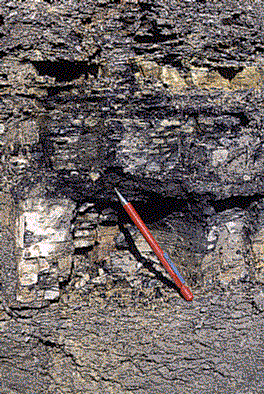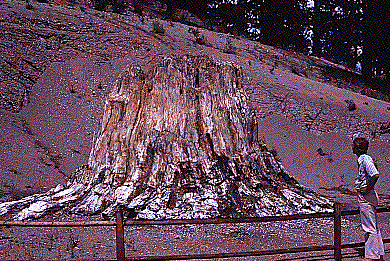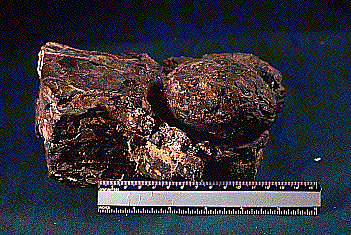Which Fossil Type Is Made From Minerals That Form Stone After The Animal Decays?
What is permineralization ?
One of the common types of fossils is permineralization. This occurs when the pores of the establish materials, basic, and shells are impregnated past mineral matter from the basis, lakes, or sea. In some cases, the wood fibers and cellulose deliquesce and some minerals replace them. Sometimes the mineral substance of the fossils will completely deliquesce and another minerals replace them. The common minerals that form this kind of fossils are calcite, iron, and silica.
Since the pores of the organic tissues are filled with minerals or the organic matter is replaced with minerals, the fossils are formed in the original shape of the tissue or organism, only the composition of the fossils will be different and they will be heavier.
Petrification (petros means stone) occurs when the organic matter is completely replaced by minerals and the fossil is turned to stone. This generally occurs by filling the pores of the tissue, and inter and intra cellular spaces with minerals, then dissolving the organic matter and replacing it with minerals. This method reproduces the original tissue in every item. This kind of fossilization occurs in both hard and soft tissues. An example of this kind of fossilization is petrified woods.
The process of permineralization
The footing h2o generally do not contain pure water molecules lone. Information technology is difficult to some degree significant it contains some minerals. The caste of hardness varies. The dissimilar  minerals are constitute in the footing, and water dissolves them until saturation at which point h2o will non agree any boosted mineral matter. This process is enhanced by the acidification of the water. For example, the rain water when pure in the beginning picks upwardly carbon dioxide from air and becomes a weak carbonic acrid. The organic thing in the ground, and other decomposable materials also will make ground h2o more acidic. This acidic water dissolves more than minerals.
minerals are constitute in the footing, and water dissolves them until saturation at which point h2o will non agree any boosted mineral matter. This process is enhanced by the acidification of the water. For example, the rain water when pure in the beginning picks upwardly carbon dioxide from air and becomes a weak carbonic acrid. The organic thing in the ground, and other decomposable materials also will make ground h2o more acidic. This acidic water dissolves more than minerals.
Organic tissues like wood, bone, and beat contain pores and spaces. The mineralized water fills the pores of the organic tissues and moves through the cellular spaces. During this process the saturated h2o evaporates, and the excess minerals are deposited on the cells and tissues. This process creates many layers of mineral deposits creating hard fossilized record.
What can we tell from permineralization ?
Since permineralizations of organisms are three-dimensional fossils with organic matter replaced past minerals, what they mainly tell usa are the about the internal structures of the organisms. The mineralization process itself helps to prevent tissue compaction, which could distort  the actual size proportions of the various organs. Permineralizations are also not "limited" to hard torso parts (such as bones or shells), simply tin also be found preserving soft body parts. This could exist very important to researchers who wish to await at what life was like in the past in relation to what information technology is now in the present. An example are the fragile reproductive structures of many plants. Depending on the weather condition for the fossilization process and the specific mineral that was used for the fossilization, however, varying degrees of detail do exist. Sometimes, only very differentiated prison cell types can be distinguished (such as between vascular tissue for conducting h2o and nutrients and basis tissue in plants), while in other fossils, the detail can exist then fine equally to distinguish betwixt the different organelles within the various cells.
the actual size proportions of the various organs. Permineralizations are also not "limited" to hard torso parts (such as bones or shells), simply tin also be found preserving soft body parts. This could exist very important to researchers who wish to await at what life was like in the past in relation to what information technology is now in the present. An example are the fragile reproductive structures of many plants. Depending on the weather condition for the fossilization process and the specific mineral that was used for the fossilization, however, varying degrees of detail do exist. Sometimes, only very differentiated prison cell types can be distinguished (such as between vascular tissue for conducting h2o and nutrients and basis tissue in plants), while in other fossils, the detail can exist then fine equally to distinguish betwixt the different organelles within the various cells.
There are three subgroups of permineralizations: silicification, pyritization, and carbonate mineralizations.
As with almost all fossilization processes, the specific blazon of permineralization, silicification (because of its conditions for fossilization), tells us a much well-nigh what type of environment the organism about likely lived in. This is because specific fossil types occur in environments with certain features. Silicification is a fossilization process whereby the organism is penetrated by minerals that form on the cells and cell structures. In this case, the mineral is silica, and because the mineral "follows" the internal structures of the organism during mineralization, this accounts for the amazing amount of detail institute in permineralizations. For example, (for silicification) fluids in volcanic terrain frequently contain silica that could exist absorbed past the plants themselves. This would indicate that a volcano was nearly the found in the past. An interesting indicate that this example presents is that the institute was already offset its fossilization process when information technology was withal living. The silica that is taken up by the plants become embedded within them and when they die, the cloth (silica) is already nowadays within them to apace mineralize the organism and fossilize it. The silicification process tin can often show very fine particular in this way.
Pyritization involves the mineral sulfur. Many of the plants are thus pyritized when they are in marine sediments since they frequently contain a large amount of sulfur. This could take been their natural habitat in the past or they could have been near enough to a marine environment to end upwards there to be pyritized (afterward being carried downward by a river, alluvion, or some other method). Some plants are also pyritized when they are in a clay terrain, but to a lesser extent than in a marine environment.
Carbonate mineralizations occur both in marine and nonmarine environments. The most  popular forms of carbonate mineralizations that are cited in biology are what are chosen "coal balls." Coal balls (which are often found in a circular brawl shape, which gives them their proper noun) are often a fossilization of many different plants and their tissues. Oftentimes, they occur in the presence of seawater or acidic peat. Acetate peels tin also commonly exist made to study the various organic textile trapped within a coal brawl. These peels may sometimes be fairly revealing of cellular detail.
popular forms of carbonate mineralizations that are cited in biology are what are chosen "coal balls." Coal balls (which are often found in a circular brawl shape, which gives them their proper noun) are often a fossilization of many different plants and their tissues. Oftentimes, they occur in the presence of seawater or acidic peat. Acetate peels tin also commonly exist made to study the various organic textile trapped within a coal brawl. These peels may sometimes be fairly revealing of cellular detail.
Index
Amber || Casts & Molds || Compactions || Compressions || Coprolites & Gastroliths
Drying & Dessication || Freezing || Impressions || Molecular Fossils || Permineralization
Reference || Trace Fossils || Wax & Cobblestone
Go dorsum to Home Folio
Feed Back
Source: https://ucmp.berkeley.edu/paleo/fossilsarchive/permin.html
Posted by: ortizfirembles.blogspot.com

0 Response to "Which Fossil Type Is Made From Minerals That Form Stone After The Animal Decays?"
Post a Comment